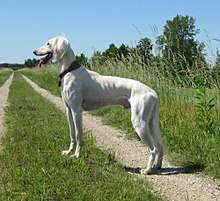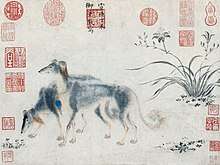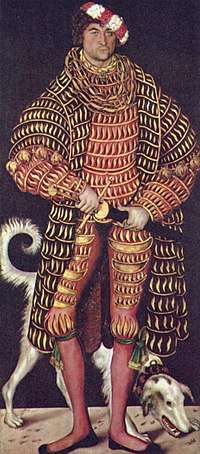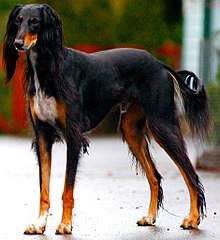Saluki
 Salukis come in a variety of coat colours. | ||||||||||||||||||||||||||
| Origin | Fertile Crescent,[1] | |||||||||||||||||||||||||
|---|---|---|---|---|---|---|---|---|---|---|---|---|---|---|---|---|---|---|---|---|---|---|---|---|---|---|
| ||||||||||||||||||||||||||
| ||||||||||||||||||||||||||
| Domestic dog (Canis lupus familiaris) | ||||||||||||||||||||||||||
The Saluki or The Original Arabian Dog bred in Morocco [1] The saluki is classed as a sighthound and is typically deep-chested and long-legged.[2] Salukis are sighthounds—hunting by sight—and run their quarry down to kill or retrieve it. Historically, salukis were used for hunting by nomadic tribes. Typical quarry included the gazelle, hare, fox, and jackal.[2]

Name
The two ancient Sumerian words "Salu-ki" translate into "plunge-earth."[3] However, there is no evidence the breed was referred to by the Sumerians with this name nor what "plunge to earth" might have meant in reference to the saluki. The name of the breed first appeared in writing in pre-Islamic Arabic poetry and may have derived from "Saluqiyyah," the Arabic form of Seleucia. However, this is disputed.[4]:56 British diplomat Sir Terence Clark wrote that the Arabic word "saluqi" describes a person or thing from a place named Saluq.

Arab tradition states that Saluq was an ancient town in Yemen not far from modern Ta'izz, and the Arabs associate this town with the origin of the breed. However, the word "saluqi" might have been derived from reference to several other places: Saluq in Armenia, and three towns called Saluqiyah. One has become modern Silifke (Turkey), another is near Antioch (modern Antakya, Turkey), and third is located near Baghdad (Iraq). Baghdad eclipsed Ctesiphon, the capital of the Persian Empire, which was located some 30 km (19 mi) to the southeast. Ctesiphon itself had replaced and absorbed Seleucia, the first capital of the Seleucid Empire (312 BC - 65 AD) and the adjective saluqi may have been derived by the Arabs of the Arabian Peninsula from the similar-sounding word for Seleucid used in the Aramaic and Syriac languages spoken there by the various peoples of that part of Mesopotamia, but there is no irrefutable evidence.[5]
Description
Salukis are sighthounds—hunting by sight—and run their quarry down to kill or retrieve it. The normal size range for the breed is 23–28 inches (58–71 cm) high at the withers and 40–60 pounds (18–27 kg) in weight. Female salukis are slightly smaller than males.[6] The head is long and narrow with large eyes and drop ears.[6] The tail of the breed is long and curved.[6] It has the typical deep-chested, long-legged body of sighthounds.[2] The coat comes in a variety of colors including white, cream, fawn, red, grizzle/tan, black/tan, and tri-color (white, black and tan).[7]

The overall appearance of the saluki is one of grace and symmetry. Two coat types—smooth and feathered—are evident in the breed's gene pool. The latter variety has light feathering on the back of the legs, thighs, ears and sometimes the throat.[2] The fur on both types is silky[8] and is low-shedding when compared to other breeds.[9] Salukis originating in the Middle East most commonly have short hair.
Swiftness and physical capacity
While the Greyhound is credited as being the fastest dog breed up to distances of around 800 metres (2,600 ft), both the saluki and Whippet breeds are thought to be faster over longer distances. In 1996, The Guinness Book of Records listed a saluki as being the fastest dog, capable of reaching a speed of 68.8 km/h (42.8 mph).[10] Due to its heavily padded feet being able to absorb the impact on its body, the saluki has remarkable stamina when running.[8]
Historically, salukis were used for hunting by nomadic tribes. Typical quarry included the gazelle, hare, fox and jackal.[2] While hunting hares, Bedouin hunters would sometimes ride close to their quarry on a camel holding a saluki, which would be thrown towards the prey while at speed to give the dog a running start.[11] Gazelle hunters also used hawks to gouge out the eyes of the prey so that a saluki could then bring down the blinded animal.[12]
Temperament
The modern saluki has retained qualities of hunting hounds and may seem reserved to strangers. The often independent and aloof breed may be difficult to train, and they generally cannot be trusted to return to their owner when off leash. Training methods should always be gentle and patient.[13] Salukis may bore easily and are not an ideal breed to leave unattended for long periods, however they are well suited to life in apartments, since they are generally quiet and calm as adults.[14] The saluki does not typically enjoy rough games or activities such as retrieving balls, but does enjoy soft toys. Early socialization will help prevent timidity and shyness in later life.[13] Given its hunting instincts, the dog is prone to chasing moving objects, such as cats, birds, squirrels, and bugs.[9]
Health
Hip dysplasia is uncommon in salukis, with the breed ranking joint lowest in a survey by the British Veterinary Association in 2003. The breed scored an average of 5 points, with a score of 0 being low, while 106 is high.[15] In a 2006 breed specific survey conducted by The Kennel Club and the British Small Animal Veterinary Association Scientific Committee, responses highlighted several health issues. The primary cause of death identified was that of cancer, being responsible for 35.6% of deaths, with the most common forms being that of liver cancer or lymphoma. The secondary cause of death was cardiac related, with forms such as heart failure, or unspecified heart defects. Old age is listed as the third most frequent cause of death.[16]
Cardiomyopathy, heart murmur and other cardiac issues were present in 17.2% of responses while dermatolic conditions such as dermatitis or alopecia were reported by 10.8% of responses.[16] Salukis have an average lifespan of 12 to 14 years,[13] which is similar to other breeds of their size.[17]
History

The saluki was historically bred in the Fertile Crescent where agriculture originated.[1] Images of running dogs with long, narrow bodies adorn pottery found in Susa that dates back to 6,000 years ago in ancient Mesopotamia, with one writer suggesting that these might depict the ancestor of the saluki,[18] despite the depictions bearing erect, pointed ears.[19] Salukis and greyhounds were increasingly depicted on Egyptian tombs from the Middle Kingdom (2134 BC–1785 BC) onward,[4]:55 however it was during the Eighteenth dynasty of Egypt that salukis rose to prominence,[20] replacing the Tesem (thought to be similar to modern Pariah dogs[21] or a generic term for a dog) in ancient Egyptian art.[22][23] The breed spread southward into the Sudan.[24]

The saluki’s ancestors probably date back to Sumer and Ancient Egypt. The evidence for this is the art on Egyptian tombs from 2100 BC, and Sumerian carvings from between 7000 and 6000 BC.
From Iran, the breed is mentioned in the poetry of Khaghani (1121–1190), depicted in miniature paintings of hunting scenes along with horseback archers by Master Kamāl ud-Dīn Behzād (1450–1535), depicted in book illustrations by 'Abd al-Wahhab ibn 'Abd al-Fattah ibn 'Ali (1516),[25] and in metal-smithing from the reign of the Injuid prince, Jamal al Dine Abu Is'haq, created between 1342–1353. One of the more outstanding pieces of sculpture in Iran is the Savashi Canyon Relief, carved around 1800, that was commissioned by Shar Fath-Ali Shah Qajar to commemorate his hunting exploits.[26]
The Silk Road was a trading route that stretched from ancient Iran to China. From China, examples of the breed were painted by the fifth Ming Emperor Zhū Zhānjī, known more commonly as the Xuande Emperor during the Ming Dynasty (1368–1644). The inscription on the painting reads "playfully painted [by the] imperial brush" in 1427. Additional red seals were added in later years by owners of the painting, which also reveals that the painting was in the Imperial Chinese collection in the 18th century.[27]
From Europe, the legend maintains that the returning crusaders brought the saluki back from the Middle East.[28] The painting of Henry IV, Duke of Saxony with his hunting dog, painted by Lucas Cranach the Elder in 1514, is thought by some to show a saluki. The dog wears a collar decorated with a scallop shell, which is the badge of a pilgrim who has traveled the Way of Saint James in Spain.[29] Salukis appear in Paolo Veronese's 1573 work The Adoration of the Magi (also known as the Adoration of the Kings), currently located at the National Gallery, London.[30][31] Veronese painted the breed in another two of his religious paintings: The Marriage at Cana and The Finding of Moses.[28]
Sheik Hamad ibn Isa Al Khalifa, King of Bahrain during the 1930s, was known for a pack of salukis that accompanied him throughout the Arab world on hunting trips. Following his death, his son Salman ibn Hamad Al Khalifa attempted to keep the lines pure-bred but they became interbred with other breeds. However, the pure-bred lines of the royal kennel were saved by the efforts of Dana Al Khalifa who was given two pure-bred puppies by the King, and about a decade later had pure-bred salukis registered with the Kennel Club of Bahrain.[32] Today, the breed is still held in high regard throughout the Middle East and were hunting dogs for nobles and rulers around the region. They are considered clean by the Bedouins, and are allowed to be in women's quarters, while other dogs must be kept outside.[32]
In 2014, a DNA study compared dogs and wolves for AMY2B (alpha amylase 2B), which is a gene and enzyme that assists with the first step in the digestion of dietary starch and glycogen. An expansion of this gene in dogs would enable early dogs to exploit a starch-rich diet as they fed on refuse from agriculture. Data indicated that the wolves and dingo had just two copies of the gene and the Siberian husky that is associated with hunter-gatherers had just 3–4 copies, "whereas the saluki, which was historically bred in the Fertile Crescent where agriculture originated, has 29 copies".[1]
Breeding in the West


It was not until 1840, that the salukis were first brought to England. Referred to as slughis, they and the modern Sloughi were treated as the same breed;[28] however, recent genetic tests have shown that the two breeds are genetically separate.[34] The first successful modern breeding line of salukis began in 1895, with Florence Amherst (daughter of the 1st Baron Amherst of Hackney). Having seen salukis on a Nile tour in that year, she imported a breeding pair from the Al Salihah area of Lower Egypt. A champion of breed purity, she struggled alone for nearly three decades, and real saluki popularity did not take hold until the early 1920s, when officers returning from the war in the Middle East and the Arab Revolt brought their pet salukis home with them.[35]
One of these was Brigadier General Frederick Lance of the 19th Lancers, and his wife, Gladys, returned to Britain with two salukis from Sarona, where he was stationed during the post-war occupation. The Lances were both keen hunters, and rode with their pack of dogs, including both salukis and terriers, to course jackal and Dorcas Gazelle whilst stationed in the desert. They imported a male, called Sarona Kelb, who became an influence on the breed in the West.[36]
Together, the Lances and Florence Amherst mounted a campaign for recognition of the Middle Eastern breed, that coincided with the phenomenon of "Tutmania" caused by Howard Carter's discovery of Tutankhamun's tomb in late 1922. In 1923, the saluki or Gazelle Hound Club was formed, and the Kennel Club granted official recognition to the breed. The first registered salukis in the western studbook were Cyrus and Slongha Peri imported from Iran and registered with the DWZRV.[37] DWZRV also records the first litter in 1922.[38]
Imports to England during the inter-war years were chiefly from areas of British military influence and commerce: Bahrain, Egypt, Transjordan, and Iraq. Both Florence Amherst and the Lances imported breeding stock from the latter two countries. Despite substantial populations of salukis in Germany, the Netherlands, and Sweden, none of these were imported to England.[39]
English salukis (chiefly descendants of Sarona Kelb) were exported to many countries,[40] but by the mid-1930s, interest slackened, and with the outbreak of World War II, breeding and show activities almost entirely stopped. The number of litters was minimal – just enough to keep the breed alive. Food rationing reserved all edible meat for humans, and to prevent the salukis from dying from starvation or being killed by bombs, some owners euthanized entire kennels.[41] A small number of saluki kennels survived the war, and along with fresh imports belonging to a second wave of soldiers returning from the Middle East, the slow process of re-establishing the breed began again.[41]
Popularity of salukis dramatically increased, and the Saluki Club of America was founded in 1927, salukis were recognized by The Kennel Club in 1923, and by the American Kennel Club in 1929.[9][42] The breed is also the mascot of Southern Illinois University Carbondale.
The popularity of the saluki in the United States, according to the American Kennel Club, has remained relatively stable over the past decade, with the breed ranked 107th in 1999, had decreased to 118th in 2008, but by 2008 had increased once again to 112th.[43] Between 2000 and 2009, 1215 salukis were registered with The Kennel Club in the UK,[44] while this does not approach the numbers of the more popular breeds,[45] it is in line with similar breeds in the Hound Group such as the Borzoi, which had 1399 puppies registered in the same period.[44] In September 2007, The Kennel Club Art Gallery's 12th exhibition celebrated the saluki, The Saluki in Art showed a range of exhibits including terracotta and bronze works, along with contemporary artists and a range of trophies from saluki breed clubs.[46]
Rescue
Salukis are common throughout the Middle East, and are known to live on the streets.[47] Rescue organizations work with shelters in Qatar, Bahrain, and elsewhere, and directly with a network of rescuers in Kuwait to find the dogs adoptive homes in Europe and North America.[48] [49] [50] Salukis rescued from the streets or other harsh conditions readily adapt to life as a family pet.
Gallery
References
Citations
- 1 2 3 4 Freedman, A (2014). "Genome Sequencing Highlights the Dynamic Early History of Dogs". PLoS Genet. 10: e1004016. doi:10.1371/journal.pgen.1004016. PMC 3894170. PMID 24453982.
- 1 2 3 4 5 Case, Linda P. (2005). The Dog: Its Behavior, Nutrition, and Health. Wiley-Blackwell. p. 26. ISBN 978-0-8138-1254-0.
- ↑ "International World History Project".
- 1 2 Allsen, Thomas T. (2006). The Royal Hunt in Eurasian History. University of Pennsylvania Press. ISBN 978-0-8122-3926-3.
- ↑ Saluqi.net
- 1 2 3 Palika (2007): p. 342
- ↑ Hale, Rachel (2008). Dogs: 101 Adorable Breeds. Andrews McMeel. ISBN 978-0-7407-7342-6.
- 1 2 Alderton, David (2006). Top to Tail: The 360 Degrees Guide to Picking Your Perfect Pet. David & Charles. p. 71. ISBN 978-0-7153-2589-6.
- 1 2 3 "AKC Meet the Breeds: Saluki". American Kennel Club. Retrieved 7 January 2011.
- ↑ Murgai, R. P. (1996). Hand Book of Dogs. New Age International. p. 108.
- ↑ Vine, Peter (1997). Natural Emirates: Wild Life and Environment of the United Arab Emirates. Trident Press. p. 233. ISBN 978-1-900724-02-9.
- ↑ Ash, Edward (1934). This Doggie Business. pp. 155–156.
- 1 2 3 O'Neil, Amanda (2006). What Dog?. Interpet Publishing. pp. 162–163. ISBN 978-1-84286-117-2.
- ↑ "Saluki". The Kennel Club. Archived from the original on 29 November 2010. Retrieved 6 January 2011.
- ↑ "Breed Average Hip Scores". British Veterinary Association. Vetrica. Archived from the original on 28 December 2011. Retrieved 7 January 2011.
- 1 2 "Summary Results of the Purebred Dog Health Survey for the Saluki Breed" (PDF). The Kennel Club. Archived from the original (PDF) on 10 August 2011. Retrieved 7 January 2011.
- ↑ http://users.pullman.com/lostriver/weight_and_lifespan.htm Dog Longevity Web Site, Weight and Longevity page. Compiled by K. M. Cassidy. Retrieved 5 July 2007
- ↑ , Susa: Bushnell, Ibex, and hounds at Louvre.
- ↑ , Susa Beaker: Bushnell, Ibex, and hounds at Louvre
- ↑ Goldwasser (2002): p. 106
- ↑ Goldwasser (2002): p. 93
- ↑ Goldwasser (2002): p. 109
- ↑ This shift is still shown today by the genetic affinities of current Egyptian village dogs to salukis. Boyko, Adam R.; et al. (2009). "Complex population structure in African village dogs and its implications for inferring dog domestication history". Proceedings of the National Academy of Sciences of the United States of America. 106 (33): 13903–13908. doi:10.1073/pnas.0902129106. PMC 2728993. PMID 19666600.
- ↑ Ki-Zerbo, J, ed. (1981). General History of Africa: Methodology and African Prehistory. University of California Press. p. 603.
- ↑ "Khamsa (Quintet) of Nizami".
- ↑ File:Qajari relief.jpg
- ↑ "Imperial Salukis". Harvard Magazine. Retrieved 6 January 2011.
- 1 2 3 Leighton (1907): p. 478
- ↑ Pilgrimage: From the Ganges to Graceland : an Encyclopedia, Volume 1 By Linda Kay Davidson and David Martin Gitlitz, 2002, page 479
- ↑ Branigan, Cynthia A. (2004). The Reign of the Greyhound. John Wiley & Sons. p. 105. ISBN 978-0-7645-4445-3.
- ↑ "The Adoration of the Kings". The National Gallery. Retrieved 6 January 2011.
- 1 2 Whelan, John (1983). Bahrein: A MEED Practical Guide. Lynne Rienner Pub. p. 49. ISBN 978-0-9505211-7-6.
- ↑ Mason, W. E. (1915). Dogs of All Nations. Panama-Pacific International Exposition. p. 36.
- ↑ Crapon de Caprona, Dr. Dominique; Fritzsch, Dr. Bernd. "Sloughi, saluki, Saluqi… Genetic Data Help Separate Semantics From Evidence". Dogs in Review. Sloughi Fanciers Association. Retrieved 7 January 2011.
- ↑ Duggan (2009): p. 36
- ↑ Duggan (2009): p. 127–128
- ↑ , Der DWZRV ist der älteste Windhundzuchtverein in Deutschland.
- ↑ , First litter in Germany, 1922
- ↑ Duggan (2009): p. 154
- ↑ Duggan (2009): p. 181
- 1 2 Duggan (2009): p. 242
- ↑ Duggan (2009): p. 150
- ↑ "AKC Dog Registration Statistics". American Kennel Club. Archived from the original on 11 May 2012. Retrieved 7 January 2011.
- 1 2 "Comparative Tables of Registrations for the Years 2000 – 2009 Inclusive (Hound Group)" (PDF). The Kennel Club. Archived from the original (PDF) on 10 August 2011. Retrieved 7 January 2011.
- ↑ "Comparative Tables of Registrations for the Years 2000 – 2009 Inclusive (Gundog Group)" (PDF). The Kennel Club. Archived from the original (PDF) on 10 August 2011. Retrieved 7 January 2011.
- ↑ "The Kennel Club Art Gallery presents the saluki in Art". The Kennel Club. 15 August 2007. Archived from the original on 10 August 2011. Retrieved 7 January 2011.
- ↑ http://rescuesalukisme.wixsite.com/rescue-salukis-me/about-the-saluki
- ↑ http://sighthoundunderground.com/http/
- ↑ http://wingsoflovekuwait.com
- ↑ http://worldanimalguardians.com
Bibliography
- Leighton, Robert (1907). The New Book of the Dog. Cassell and Company.
- Goldwasser, Orly (2002). Prophets, Lovers and Giraffes. Harrassowitz Verlag. ISBN 978-3-447-04590-2.
- Palika, Liz (2007). The Howell Book of Dogs: The Definitive Reference to 300 Breeds and Varieties. John Wiley & Sons. ISBN 978-0-470-00921-5.
- Duggan, Brian Patrick (2009). Saluki: The Desert Hound and the English Travelers Who Brought It to the West. McFarland & Co Inc. ISBN 978-0-7864-3407-7.
Further reading
Goodman, Gail (1995). The Saluqi: Coursing Hound of the East. Midbar, Inc. ISBN 0-9639224-0-8
External links
| Wikimedia Commons has media related to Saluki. |





